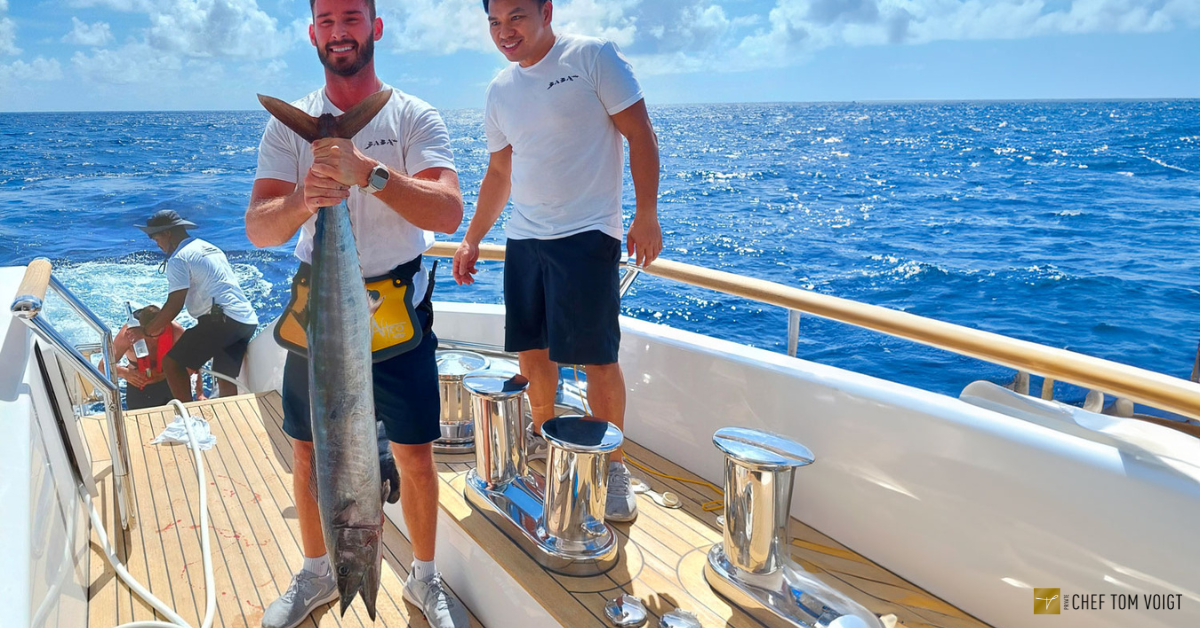
Life and work as a yacht chef
|
|
|
Time to read 4 min
|
|
|
Time to read 4 min
Table of contents
On one of my most challenging voyages, we sailed for sixteen days without seeing land. Aboard a 58-meter yacht, we left Palma de Mallorca bound for the Bahamas, making brief stops in Gibraltar, Tenerife, and Puerto Rico. During this voyage, I shared space with a diverse crew of ten people, hailing from nine different countries. As a chef, my mission was not only to feed the crew, but also to maintain their high morale and physical well-being through adequate, nutritious, and personalized food.
Cooking in such an environment goes far beyond the culinary. Yacht transfers are not just pleasure trips, but an essential part of the nautical industry, with long working days for all members. The boat becomes our home and workplace, a kind of refuge that, just as we take care of it, also protects us. I have been working as a chef on yachts for more than 14 years, and although my first experience was in 1992, each crossing continues to be a challenge and a learning opportunity.
Cooking on a yacht during an ocean crossing requires much more than culinary skill. Weather conditions can change rapidly, with waves reaching over three metres, putting not only the boat to the test, but also the crew. In situations like these, the body faces constant stress, with muscles tensed to adapt to the incessant movement of the boat. Sleeping becomes a challenge, especially when waves hit the bow directly and cause violent jolts that can cause the body to move abruptly, sometimes even throwing you to the ground.
I remember a particularly rough crossing from Malta to Saudi Arabia, where the movement of the sea threw me against the cabin ceiling on several occasions. These experiences teach you to adapt, but they also show you how vulnerable the human body can be in extreme situations.
Seasickness is a common challenge for even the most experienced sailors. The constant tossing and rolling makes simple tasks like cooking and sleeping difficult. Keeping your balance in the galley, while the waves crash, requires an extra level of concentration and adaptation. Fatigue and seasickness can lead to a feeling of mental emptiness, where the body and mind seem to disconnect.
Seasickness does not discriminate, and I have seen veteran sailors with years of experience at sea suffer as much as those venturing out for the first time. On one Atlantic crossing, I shared a cabin with a sailor who had been racing for years. Despite his experience, he succumbed to seasickness before I did. Feelings of nausea and loss of appetite are common, although in some cases, stress can cause a sudden increase in hunger.
During a voyage, nutrition is key. Before setting sail, it is vital that the crew stays hydrated and consumes nutritious food. During the voyage, the consumption of hot, caffeine-free drinks and soups is highly recommended, while alcohol should be avoided as it slows reflexes and aggravates seasickness.
As for diet, easily digestible carbohydrates such as potatoes, cereals and pasta are essential. Heavy, fatty foods make digestion difficult, especially in rough sea conditions. However, I have seen cases where, even in the middle of a storm, some sailors (myself included) wanted more sumptuous meals, even though the ship was tossing and furniture was flying around us.
Ginger is one of the most effective remedies for motion sickness. Controlled studies have shown that consuming 1-2 grams of ginger can reduce the symptoms of motion sickness. This is because ginger helps regulate the release of stress hormones, which are the ones that cause vomiting and breathing difficulties in situations of discomfort.
Cooking on a yacht requires taking extra safety measures. Pots and pans should be secured with racks and non-slip mats to prevent them from sliding around. Cupboards and drawers have locking systems, and all utensils should be secured, especially during the evenings when the sea can be rough.
As the ship tilts, even measuring equipment like scales can become ineffective. That’s why I always recommend using standard measurements like cups and spoons to ensure accuracy in recipes. Additionally, it’s essential to organize ingredients in labeled bags for easy access during difficult times.
Fortunately, motor yachts are generally more stable than sailing yachts, thanks to their stabilizers that compensate for the movements of the sea. However, on long voyages, as a chef, the galley becomes a refuge where I can offer moments of happiness to the crew through food.
The voyages, though challenging, offer a time of calm and reflection for private chefs like me. Between the tough work seasons, these trips are a chance to relax, read those books that were left unfinished, and strengthen the bonds with the crew. We become a close-knit family, sharing long watches, moments of silence under the stars, and deep conversations about life at sea.



